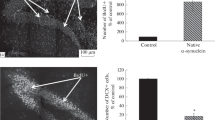Abstract
The effect of nanoemulsions (NE) of phospholipids containing astaxanthin (AST) or its esters on the spatial behavior of transgenic mice with Alzheimer’s disease 5XFAD at the age of 4–6 months is studied in an elevated plus maze and via an “open field” test. The nanoemulsions obtained by injection have a diameter of 70–100 nm and a polydispersity index of <0.3. The animals receive the preparations with food 5 times a week for two months. The dose of AST and esters is 2 mg/kg of body weight. Once a week, the animals receive a double dose of drugs. The control animals receive NE that do not contain carotenoids. Behavioral tests show that AST-treated mice spend significantly less time in the open arms of the elevated plus maze compared to the control mice. In the case of esters, no reliable significance is found. In the “open field” test, AST esters have a positive effect on the animals, slowing down thigmotaxis disorders in 5XFAD mice. At the same time, the introduction of any NE does not affect a decrease in motor activity. Hence, in Alzheimer’s mice treated with both AST and esters, the behavioral parameters in the elevated plus maze and the “open field” test tend to improve.



Similar content being viewed by others
REFERENCES
A. Reynolds, C. Laurie, R. L. Mosley, et al., Int. Rev. Neurobiol. 82, 297 (2007).
H. Akiyama, S. Barger, S. Barnum, et al., Neurobiol. Aging 21, 383 (2000).
C. Holmes, Neuropathol. Appl. Neurobiol. 39, 1 (2013).
F. L. Heppner, R. M. Ransohoff, and B. Becher, Nat. Rev. Neurosci. 16, 358 (2015).
J. Kim, Z. Kim, Z. I. Huang, et al., Biomol. Ther. 27, 327 (2019).
R. Rao, A. R. Sarada, V. Baskaran, et al., J. Microbiol. Biotechnol. 19, 1333 (2009).
Q. Chen, J. Tao, G. Li, et al., Eur. J. Pharmacol. 840, 33 (2018).
M. N. Alam, M. M. Hossain, M. M. Rahman, et al., J. Diet Suppl. 15, 42 (2018).
S. O. Rahman, B. P. Pa, S. Parvez, et al., Biomed. Pharmacother. 110, 47 (2019).
H. Che, Q. Li, T. Zhang, et al., J. Agric. Food Chem. 66, 4948 (2018).
C. Huang, C. Wen, M. Yang, et al., J. Neuroimmune Pharmacol. 16, 609 (2021). https://doi.org/10.1007/s11481-020-09953-4
I. S. Kulikova, N. Yu. Lotosh, V. A. Turanova, and A. A. Selishcheva, Khim.-Farm. Zh., No. 8 (54), 18 (2020).
P. Gentine, A. Bubel, C. Crucifix, et al., J. Liposome Res. 22, 18 (2012).
T. D. Gould, Mood and Anxiety Related Phenotypes in Mice (Humana Press, Baltimore, MD, 2009).
M. Komada, K. Takao, and T. J. Miyakawa, Vis Exp. 22, 1088 (2008).
T. P. O’Leary, H. M. Mantolino, K. R. Stover, et al., Genes Brain Behav. 19 (3), 2 (2020).
Ya. V. Gorina, Yu. K. Komleva, O. L. Lopatina, et al., Biomeditsina, No. 3, 47 (2017).
T. A. Voronina, R. U. Ostrovskaya, and T. L. Garibova, Guidelines for the Preclinical Study of Drugs with a Nootropic Type of Action. Guidelines for Conducting Preclinical Studies of Drugs, Part 1, Ed. by A. N. Mironov (Grif and K, Moscow, 2012) [in Russian].
Ya. V. Gorina, A. B. Salmina, N. V. Kuvacheva, et al., Sib. Med. Obozr., No. 4, 11 (2014).
A. Satoh, S. Tsuji, Y. Okada, et al., J. Clin. Biochem. Nutr. 44, 280 (2009).
J. Wojsiat, K. M. Zoltowska, K. Laskowska-Kaszub, and U. Wojda, Oxid. Med. Cell. Longev. 2018, 1 (2018). https://doi.org/10.1155/2018/6435861
S. J. Lee, S. K. Bai, K. S. Lee, et al., Mol. Cells 16, 97 (2003).
E. Fanaee-Danesh, C. C. Gali, J. Tadic, et al., Biochim. Biophys. Acta Mol. Basis Dis. 1865, 2224 (2019).
A. Sangsuriyawong, M. D. Limpawattana, and W. Siriwan Klaypradit, Food Sci. Biotechnol. 28, 529 (2019).
T. Taksima, P. Chonpathompikunlert, M. Sroyraya, et al., Mar. Drugs 17 (11), 3 (2019).
Y. Yao, M. Jia, J. G. Wu, et al., Pharm. Biol. 48, 801 (2010).
E. O. Petukhova, Ya. O. Mukhamedshina, A. A. Rizvanov, et al., Geny Kletki, No. 3 (9), 234 (2014).
S. Jawhar, A. Trawicka, C. Jenneckensa, et al., Neurobiol. Aging 33, 196 (2012).
N. S. Nikolaeva, A. V. Mal’tsev, R. K. Ovchinnikov, V. B. Sokolov, A. Y. Aksinenko, E. V. Bovina, and A. S. Kinzirsky, Biol. Bull. 46, 268 (2019).
M. M. Chicheva, A. V. Mal’tsev, V. S. Kokhan, and S. O. Bachurin, Dokl. Akad. Nauk, Nauki Zhizni 494, 468 (2020).
F. Schneider, K. Baldauf, W. Wetzel, and K. G. Reymann, Physiol. Behav. 135, 25 (2014).
ACKNOWLEDGMENTS
We are grateful to staff member A.V. Kryuchkova of the Faculty of Biology, Lomonosov Moscow State University, for her great contribution to evaluation of the results and the text of this article, M.Yu. Kopaeva (Resource Center for Neurocognitive Research, National Research Center “Kurchatov Institute”) for assistance in working with the laboratory animals, the Resource Center for Neurocognitive Research, National Research Center “Kurchatov Institute” for providing equipment, and A.V. Symona (Representative office of Lipoid AG in Moscow) for providing phospholipids.
Funding
The work was supported by the National Research Center “Kurchatov Institute” (Research Center “Biomedical Technologies,” subtopic 2, order no. 1059 dated July 2, 2020).
Author information
Authors and Affiliations
Corresponding author
Rights and permissions
About this article
Cite this article
Lotosh, N.Y., Kryuchkova, A.V., Kulikov, E.A. et al. Effect of Nanoemulsions Containing Astaxanthin or Its Esters on the Spatial Behavior of 5XFAD Mice. Nanotechnol Russia 17, 227–234 (2022). https://doi.org/10.1134/S2635167622020124
Received:
Revised:
Accepted:
Published:
Issue Date:
DOI: https://doi.org/10.1134/S2635167622020124




